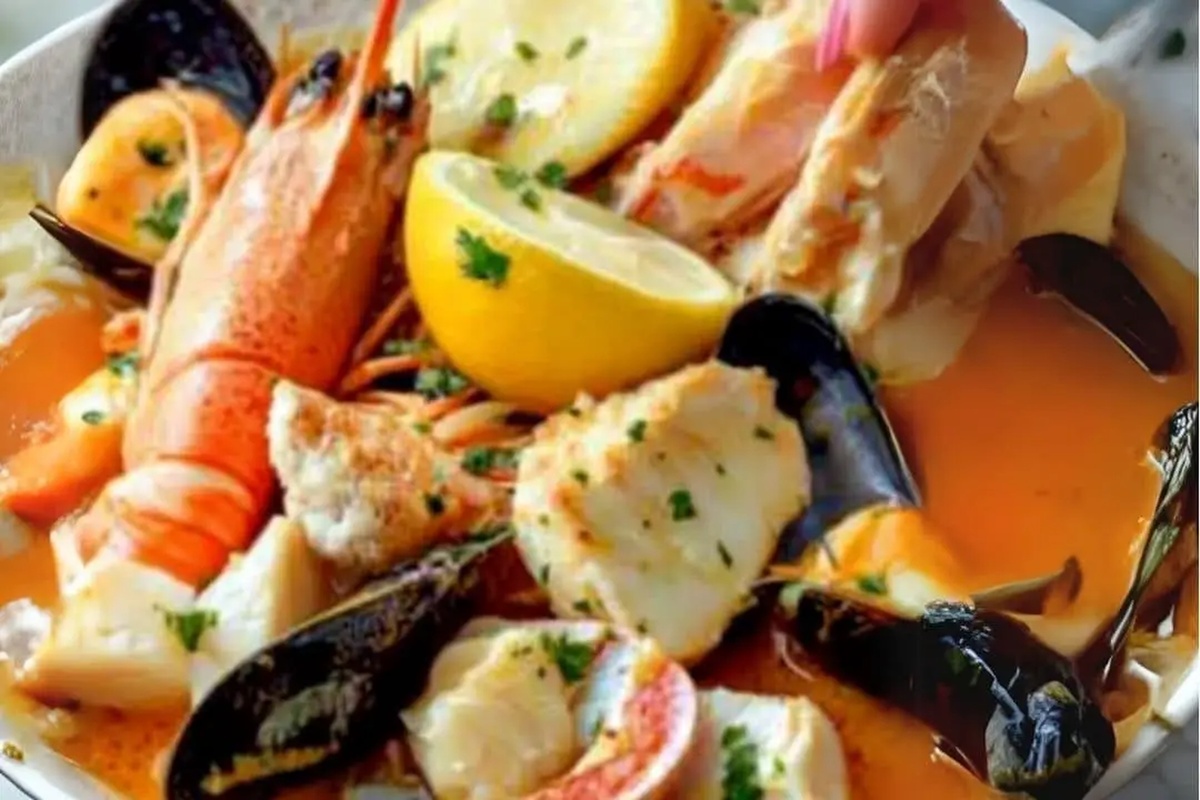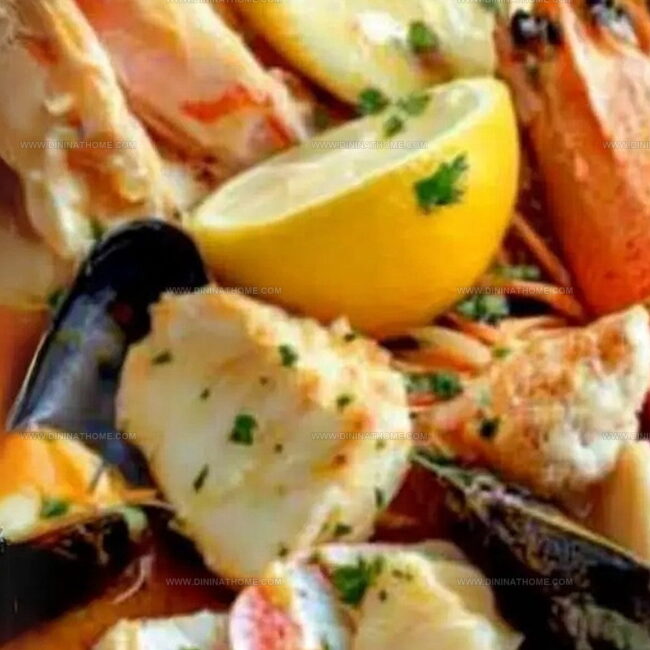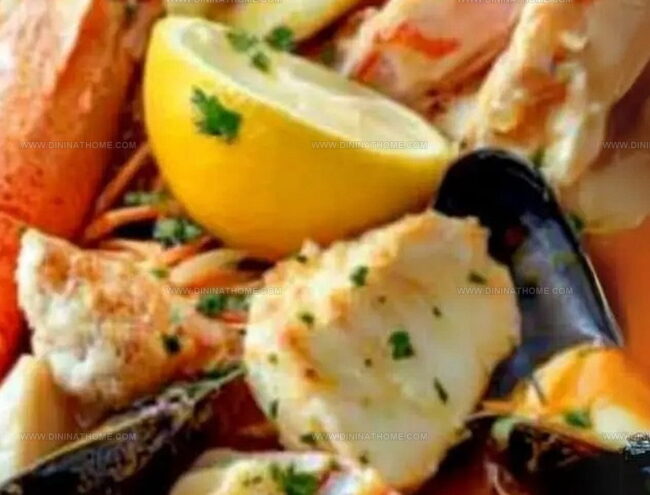Rustic French Bouillabaisse Recipe: A Coastal Seafood Delight
Mediterranean fishermen crafted this hearty bouillabaisse recipe centuries ago along the rocky coastlines of Provence.
Salty sea breezes and fresh-caught seafood inspired their robust culinary creation.
Marseille’s legendary fishers developed a stew that celebrates ocean bounty with intense, layered flavors.
Local ingredients like rascasse, red mullet, and scorpion fish became signature components of this traditional dish.
Fragrant saffron and fennel add complex aromatics that transport you straight to southern French harbors.
Each spoonful tells a story of maritime culture and culinary passion.
You can recreate this authentic coastal experience right in your kitchen, connecting with generations of seafood traditions.
Seafood Depth and Rich Broth – Why Bouillabaisse Feels Special
Bouillabaisse (Elegant Seafood Stew) Ingredients
Base Vegetables:Aromatics and Spices:Seafood Selection:Liquid Base:Finishing Touches:Serving Accompaniments:Bouillabaisse Stew Prep Guide
Step 1: Create Aromatic Base
Heat olive oil in a large pot over medium flame.
Toss in onions, leeks, garlic, and fennel.
Sauté these vegetables until they become soft and release their wonderful fragrance, stirring occasionally to prevent burning.
Step 2: Develop Rich Flavor Profile
Introduce chopped tomatoes, saffron threads, fresh thyme, and bay leaf into the pot.
Stir gently and allow ingredients to mingle for a few minutes, creating a deep and complex flavor foundation.
Step 3: Build Liquid Foundation
Pour fish stock and white wine into the pot.
Let the liquid gently simmer, allowing all the herbs and vegetables to infuse their essence.
Season with salt and pepper, tasting and adjusting as needed for perfect balance.
Step 4: Select Fresh Seafood
Carefully add an array of seafood to the bubbling broth:Cook until seafood is just tender and shellfish have opened their shells completely.
Discard any shellfish that remain closed.
Step 5: Elevate with Fresh Herbs
Remove pot from heat.
Sprinkle freshly chopped herbs over the stew:Squeeze fresh lemon juice to brighten the entire dish.
Step 6: Prepare Elegant Presentation
Ladle steaming bouillabaisse into wide serving bowls.
Accompany with crusty baguette slices and optional rouille sauce for an authentic French coastal experience.
Seafood Stew Guidance for Elegant Bouillabaisse
Bouillabaisse Stored Safely
Top Flavor Pairings for Bouillabaisse
Elegant Bouillabaisse: A Rich Seafood Stew Experience Stew Variations
FAQs
Bouillabaisse originated in Marseille, France, as a traditional fisherman’s stew made from the day’s unsold catch. Fishermen would cook their least marketable fish with local Mediterranean herbs and spices.
A mix of firm white fish like cod or halibut, shellfish such as mussels, clams, and shrimp create the perfect seafood combination. The key is using fresh, high-quality seafood that can hold up during cooking.
Saffron provides a distinctive golden color and unique flavor that is essential to authentic Bouillabaisse. It adds a subtle, earthy warmth and complexity to the seafood broth that cannot be replicated by other spices.
Seafood is done when fish turns opaque and flakes easily, shrimp becomes pink and curled, and shellfish like mussels and clams open completely. Discard any shellfish that remain closed after cooking.
Print
Bouillabaisse Recipe
- Total Time: 50 minutes
- Yield: 4 1x
Description
Marseille’s legendary Bouillabaisse combines Mediterranean seafood and aromatic herbs in a luxurious broth that sings with coastal flavors. Fishermen’s traditional recipe delivers complex layers of taste, inviting you to savor each spoonful of this classic French coastal delicacy.
Ingredients
Seafood:
- 1 pound firm white fish fillets (such as cod, halibut, or snapper), cut into chunks
- 1/2 pound shrimp, peeled and deveined
- 1/2 pound mussels, cleaned
- 1/2 pound clams, cleaned
Vegetables and Aromatics:
- 1 large onion, chopped
- 1 leek, cleaned and sliced
- 2 cloves garlic, minced
- 1 fennel bulb, chopped
- 1 large tomato, peeled and chopped
Herbs, Spices, Liquids, and Additional Ingredients:
- 2 tablespoons olive oil
- 1/2 teaspoon saffron threads
- 1 teaspoon dried thyme
- 1 bay leaf
- 4 cups (1 liter) fish stock
- 1/2 cup (120 milliliters) dry white wine
- Salt and pepper to taste
- 2 tablespoons fresh parsley, chopped
- 1 tablespoon fresh basil, chopped
- 1 tablespoon fresh lemon juice
- 1 baguette, sliced
- 1/4 cup (60 milliliters) rouille sauce (for serving, optional)
Instructions
- In a spacious cooking vessel, warm olive oil at medium temperature, introducing chopped onion, delicate leek, aromatic garlic, and fennel. Gently transform the vegetables, stirring until they soften and release their delightful fragrance, approximately 7-8 minutes.
- Incorporate diced tomatoes, golden saffron threads, earthy thyme, and aromatic bay leaf into the vegetable mixture. Allow these ingredients to intermingle and the tomatoes to gently break down over 2-3 minutes.
- Pour in rich fish stock and crisp white wine, creating a flavorful liquid foundation. Encourage the broth to simmer softly, melding the complex flavors and developing depth for 15-20 minutes. Season with salt and pepper, adjusting to personal taste preferences.
- Carefully introduce an array of seafood – delicate white fish, succulent shrimp, briny mussels, and tender clams. Let the marine treasures poach gently in the fragrant broth for 5-7 minutes until perfectly cooked. Vigilantly remove any shellfish that remain closed.
- Elevate the stew’s brightness by stirring in freshly chopped parsley, vibrant basil, and a splash of zesty lemon juice. Remove from heat to preserve the herbaceous essence.
- Artfully ladle the rich bouillabaisse into warm serving bowls. Accompany with crusty sliced baguette and optional dollop of spicy rouille sauce for an authentic Mediterranean experience.
Notes
- Pick robust, fresh seafood for the most authentic flavor and best texture in your bouillabaisse.
- Use traditional Mediterranean white fish like red mullet, sea bass, or monkfish for true regional authenticity.
- Consider making this gluten-free by replacing baguette with gluten-free bread or serving over cauliflower rice.
- Adjust seafood cooking time based on individual piece sizes to prevent overcooking and maintaining tender, succulent meat.
- Prep Time: 20 minutes
- Cook Time: 30 minutes
- Category: Dinner
- Method: Sautéing
- Cuisine: French
Nutrition
- Serving Size: 4
- Calories: 320
- Sugar: 3 g
- Sodium: 600 mg
- Fat: 12 g
- Saturated Fat: 2 g
- Unsaturated Fat: 8 g
- Trans Fat: 0 g
- Carbohydrates: 30 g
- Fiber: 2 g
- Protein: 24 g
- Cholesterol: 70 mg




Emily Harper
Nutrition Consultant & Recipe Analyst
Expertise
Healthy Recipe Modification, Nutritional Analysis & Meal Planning, Global Cuisine & Dietary Adaptations
Education
School: French Pastry School, Chicago, IL
Program: L’Art de la Pâtisserie
Focus: Intensive training in traditional French pastry techniques, baking theory, and confectionery arts.
Emily’s journey started in a pastry kitchen but took a detour into the world of health and flavor science.
Graduating from the French Pastry School and studying nutrition opened her eyes to a new mission: making healthy food taste like something you’d actually crave.
At Dining At Home, Emily’s the go-to for smart, feel-good recipes that don’t trade flavor for nutrition.
She’s all about adding a fresh spin on old favorites and finding small ways to make everyday meals a little brighter.
Outside of the kitchen, Emily is most at home walking forest trails, testing plant-based recipes, or sharing a picnic under a wide-open sky.